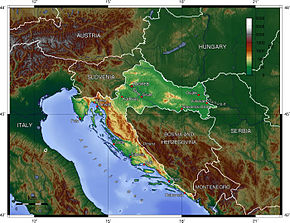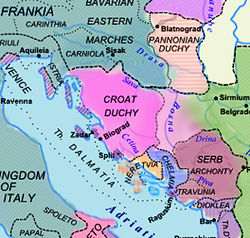Directory talk:Croatia
Notes
- Byzantines-Eastern Roman Empire (i.e. Procopius-Byzantine scholar, Jordanes- 6th century Roman bureaucrat) c. 550 Σκλαβῖνοι- Sklabenoi
- Latin: Sclaveni
- It is believed that Hrvat in medieval times was pronounced "Harvat or Hrovat".
- Discovered In 1853 Χορούαθ[ος], Χοροάθος, Χορόαθος- Horoúathos, Horoáthos, and Horóathos (originally 3rd century AD-Tanais Tablets)
- Branimir's inscription c. 880: Croatorum (Latin)
- Baska tablet c.1100 AD: HR'VAT'SKI
Hrvat in medieval times was pronounced "Harvat or Hrovat". Harvat/Hrovati was translated to Latin: Chroatorum and then simplified to Croatorum.
Modern Croatian: Hrvatska
Chakavian Slavs
Old Chakavian Slavic speakers (Croatian tribes) must have arrived in the early 700s (8th Century AD) and made the Dalmatian hinterland there home, one group went west as far as Histri (modern: Istria) and the other eastward to Montenegro.
There are no contemporary written records of Chakavian-Slavic speakers (Croatian tribes) invasion/migration/settlement or about the events as a whole within the area itself. It is quite possible that the area had a drop in population and the military presents of the Byzantine Empire (Eastern Roman Empire) and the Carolingian Empire was minimal or even non existent. This would have lead to an easy invasion the of the area (opportunity beckons). The Roman Latin-Illyrian population as well as Liburnians, Greeks and others would have to have endured the arrival of the Sclaveni (Slavs). The Roman population survived within the coastal cities, for a while on the islands and in the inhospitable Dinaric Alps.
It is quiet possible the success of the Chakavian-Slavic tribes set the precedent for the Kajkavian-Slavic speakers and Shtokavian-Slavic speakers to follow suit. There is a probability that the eastern Chakavian-Slavic tribes and Shtokavian-Slavic speakers started to mix with the Shtokavian-Slavic language becoming the Lingua Franca within the eastern part of Old Roman Dalmatia (thus begins Shtokavian-Slavic language move westward).
The first written records of Croatians started in the late 8th and early 9th century. I believe one of the reasons was the case is that the Croatian tribes started to become western Europeanised. Within Dalmatian Ducatus of the Carolingian Empire certain Croatian leaders became the political elite and took political leadership. In order to keep this they became Christians thus connecting with Rome (via Carolingian Empire, the Dalmatian Roman City States and the Republic of Republic of Venice). Then we have creating military alliances and trade with neighbors, etc.
Chronology
Prehistoric Croatia
- Roman Empire
- Ostrogoth Kingdom
- Carolingian Empire
With time one of the Slavic tribes within Dalmatian Ducatus of the Carolingian Empire became the political elite and the leaders (dux) of the province. It goes independent ......
Historic Croatia
- Kingdom of Croatia (925–1102)
then became part of ..... Kingdom of Hungary or Regnum Hungariae Some time after it lost its independents, the state Kingdom of Croatia (Regnum Chroatorum) in 1102, the political power within the Provence was transferred from Northern Dalmatia (no permanent seat. Nin, Klis, Bijaci and Knin) to the city of Zagreb, further inland (Zagreb was a Roman town of Andautonia). Zagreb today is the capital of modern Croatia.
Note: Harvat/Hrovati had there own province, the diplomatic name of the kingdom was "Kingdom of Croatia and Dalmatia" (Latin: Regnum Croatiae et Dalmatiae). Common Croatian language form of the name was Hrvatska Zemlja (Croatian country or 'Croatian land').
- Habsburg Monarchy - Austro Hungarian Empire
(Republic of Venice & Ottoman-Turkish Croatia)
- Yugoslavia
- Republic of Croatia
Habsburg Monarchy - Austro Hungarian Empire
Croatian territory under Habsburg rule was reduced to about 20,000 km².
Under Habsburg Monarchy
- we have Kingdom of Croatia
- then expanded Kingdom of Croatia-Slavonia
Yugoslavia
- During the history of Yugoslavia we have the Banovina of Croatia & Socialist Republic of Croatia.
These provinces incorporated Austro Hungarian Empire's old Kingdom of Dalmatia which included Republic of Ragusa's (Dubrovnik) old territory.
This means further territorial expansion to the current Croatia.
.

